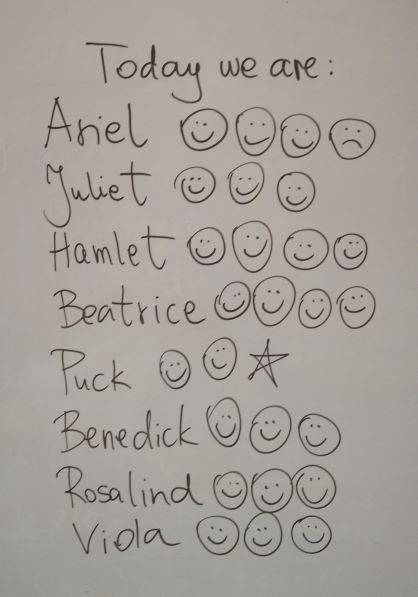Back in the classroom
January, January. Here we are, are still dragging the residue of the Xmas – New Year laziness in our blood cells but the time is now to enter the classrooms briskly (also, because the school hallways is the only place where you can do ‘briskly’, the pavements outside are either icy or covered with snow or slush), with the new energy and to start the second half of the game.
Sometimes, let’s be honest, this YAY attitude is a show you put on (see the laziness residue) but if it doesn’t start with the teacher, then there is no or very little hope that it will be student-generated. After all, they don’t only have you, their after-school English classes, they also have the regular school, with the huge piles of homework and, this year’s special – they are back to the regular, offline classrooms, after three months of the screen’n’pjs education. This is the older students.
The younger ones, well, they have been attending regular classes, without any breaks, in most cases, but these, they come after not having seen you for two weeks. Will they be a little bit displaced and confused? Yes, they will. Will they have forgotten some of the class rules and routines? Most likely, yes. Will this first lesson after the winter holidays be to some extent like the first lesson of the course? It might be.
What to do with it? Not much, really. Just being kind to yourself and to your students and acknowledging the fact that it will take some time to warm up the neurons and to have them work at the top of their capacity. And a lot of revision, as regards vocabulary, structures, rules and routines. It is not that difficult to put together a great and meaningful ‘revision’ lesson and all the students will appreciated and enjoy doing something that is familiar (but not boring) and achievable (but still challenging enough). Before we get back to climbing yet another of our EFL Everests.
But that’s not really what I wanted to write about today
Imagine, dear reader, that to all the hoops that are already in place (a long break, sleepy students, tired students, all over the place students), you get one more: you find out that a brand new student will be joining your group. Or coming to do a trial lesson. Or just joining you for a catch-up lessons since he/she missed a few classes with their regular teacher.
I am not sure how common an occurence that would be in state schools, kindergartens or classes given by private tutors, or, even, whether it does happen in other private language schools. It does in mine and it is an interesting experience. Here are few thoughts from the last two weeks.
The teacher
It is a challenge, admittedly, because in a way we work the double amount, on the one hand dealing with the group, re-instating the kingdom from before, on the other hand, taking the new student on a brand new adventure and that might mean some temporary dissonace that will have to be managed.
It might also happen that the new student’s mum will want to take part in the lesson or that the new child will refuse to enter the classroom without her. How you react here will, of course, depend on the school’s policy.
It might be a good idea to invite the parents in or to have them sit in the hallway but with the door open so that everyone (the parent and the child) feel comfortable and it is equally important for the teacher to explain what is going to happen in the lesson and how the parents can help. What usually happens is, the child stays around mum in the very beginning and then, slowly, wanders towards the teacher and the group and, eventually, takes part in all the activities. This period of time might be different for different children and it is crucial that they are not rushed here, by the teacher or by the parents, and that they make the decision when to join all by themselves.
The best advice that I might give teachers (and that I give myself when I enter the room on a day like this) is to stay calm and to smile a lot, because things will get better soon. Of course, in 2020 – 21 even smiling might not such a straightforward solution, but even with the mask on, it is good to remember that it takes a few muscles to smile and that the smile spreads all over your face. Plus, it might be a good idea, to stand at a safe distance and to take off the mask just for a second, while meeting the child for the first time to let them see your face.
The activities
This is an interesting case, especially with the very young learners. As mentioned before, some revision is absolutely necessary in any lesson and especially in the first lesson after a long break. However, that might mean that the new students will be constantly at a disadvantage, because for example, they won’t know all the songs that everyone else already loves or to take part in all the games because in order to do so, they would have to be familiar with all the vocabulary and, of course, they are not.
For that reason, it would be good to start each activity with a quick revision of the vocabulary and drilling, to inlcude the games that will have a double focus, something apart from the language itself, for example langauge and CLIL (names of the animals and whether they are big or small or numbers and counting real objects) or language and cognitive skills (names of toys and looking for differences between two pictures or odd one out) because the new students will be able to participate partially at least, relying on their ‘previous knowledge’ not on the langauge only in order to complete the tasks.
What’s more, despite the overall focus on the revised, I would still recommend introducing some new material, in order to ensure that there is something which is new to absolutely everyone, the ‘old’ students and the new and that we all learn it, together, as a group. It doesn’t have to be a brand new topic, only a couple of new items to extend their vocabulary range in the topic of toys, a new song or a new story.
Using gestures is always a good idea, but it can be especially beneficial in the begining of the course, the new topic or when there is a new student in the group. They might not be able to produce all the words straightaway but they should be able to show them, if they know how.
As for songs and videos, in general, although there are plenty of advantages of using a mixture of both audio and video or even moving to using audio only, once the kids know the song very well, the videos will help to support the new kids for whom all is new. At the very minimum, they will be able to follow and understand the plot of the song.
The new child
Well, in a way, this is the most important person in the room as this is, definitely, the most confused, the most singled-out and the most vulnerable person in the room. The adults definitely know what is going on, what we are doing and why we are here. The other non-adults, albeit a bit out-of-sync perhaps, also seem to recognise the set-up and the procedures and they also know each other.
The reactions to this amount of ‘new and unfamiliar’ might vary, from a complete disregard for it (‘There are other kids, they do something, I want to do it, too! What, they use some strange words all the time? Nevermind! ‘), through one million questions in an attempt to take the situation in (‘Why?‘ ‘Who?‘ ‘What?‘ ‘Why?‘ ‘Why?‘ ‘Why?‘) to a complete refusal to take part (‘I can’t, I won’t‘)
As I said before, it is rare that the children are completely uninterested and not ready to be involved. Usually, it wears off during the first fifteen minutes so it is only up to the teacher and the parents to wait it out, patiently, while providing all the support necessary.
Apart from tthe smiles and the praise, all the new activities should be modelled and demonstrated with the other students. This way, the newcomers will have a chance to see the game in action before it is their turn to take part.
The group
This is, by far, the most interesting component of the whole set. No matter how unfocused they are, and how much they have forgotten, these are the students who have been with you for a few months and, almost automatically, they will become your teaching assistants.
You will be able to demonstrate the activities as well as the behaviour that you want to reinforce or, sometimes, too, discourage. What is more, they will naturally want to be involved and, even without you asking, they will give the new student the best introduction to all the lesson procedures, in the L1 and in a way that is best understood by a child.
It is actually a real joy to see them do that, with all the 3 or 4-year-old kindness and empathy:
‘Don’t worry, we all take turns. First me, then Anya, then Masha, then you. Don’t be sad.’
‘She doesn’t speak Russian. We speak English here.’
‘She will show us how to do it‘
‘And then we will read the story‘.
There is another reason why having a new or a guest student might be interesting. This is a truly unique (albeit unsolicited) opportunity for the teacher to see how much progress the group have made. Assessing preschoors is not as easy and straightforward as assessing other age groups, and comparing them against a beginner who is just starting to learn is fascinating. Even if seemingly, they are all still beginners, still pre-A CEFR and still in year 1, it is possible to see how much progress the children have made over a period of a few months. And it applies to all the areas, vocabulary, behaviour, social skills.
And two stories from the classroom, instead of a coda
The first one, from my preschool group a few years back. Over the course of the year, we got bored and started to come up with more creative names for things that we were using. No more of ‘orange juice’ or ‘cherry juice’, we were drinking ‘clock juice’ and ‘balloon juice’ and we were all using chocolate marker, cucumber marker, strawberry marker and sky marker, instead of all the traditional colours. It was all great and a lot of fun, until a new student joined. We just had to explain what was going on.
The second one, from my teens group. This time, it was not a new but a catch-up student. Who brought her phone and who did not switch it to mute. Whose telephone rang in the middle of the lesson, naturally. Who just picked it up and started a conversation.
We sorter it out later, of course, but before we did, I because a part of a beautiful classroom tableaux. I, in the middle, and a few of heads of my students, first turning towards the new girl and then right at me, with the same question in their eyes, ‘WHAT is she doing?!?!?!’…
It made me giggle, inside. ‘Hm, look, it seems we have a code of conduct here.’, I thought. ‘And someone feels strongly about it.’ Good to know, eh?
As for the square pegs and round holes…Well, even if they that in the beginning, during the first lesson or the first two lessons, they never stay that way. The square pegs become a bit rounder and the round holes get a bit square-y. And that is the way to go!
Happy teaching!



























